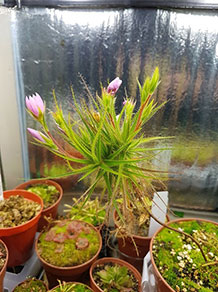Carnivorous plants

Carnivorous plants are outliers in the sense that they flip the usual relationships between plants and animals. Some plants, such as the venus flytrap, are clearly carnivorous but some of the most fascinating cases are those that are apparently on the edge of carnivory. Are plants that trap prey, but rely on other organisms (insects, bacteria) to digest the prey, truly carnivorous? We are investigating some of these ‘outliers’ using cutting edge statistical physics methodology.
The picture next to this text shows Roridula gorgonias, an example of a sticky-leaved plant that relies on commensal capsid bugs (among other species) to digest its prey. The ‘stickiness’ of the leaves is caused by tiny droplets on hairs projecting from the leaves. Roridula is unlike other sticky-leaved plants such as Drosera (the sundews) because the trapping fluid is non-aqueous – another example of how life has arrived at the same physical principle by two different evolutionary paths.
